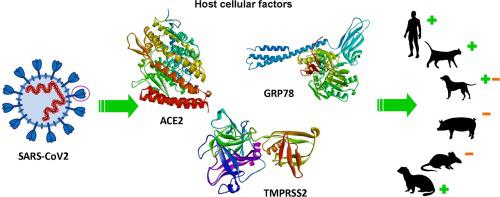Virus Research ( IF 2.5 ) Pub Date : 2020-09-09 , DOI: 10.1016/j.virusres.2020.198154 H R Rangel 1 , J T Ortega 2 , S Maksoud 3 , F H Pujol 1 , M L Serrano 4

|
Recent reports have shown that small and big felines could be infected by SARS-CoV-2, while other animals, like swines and mice, are apparently not susceptible to this infection. These findings raise the question of the role of cell factors associated with early stages of the viral infection in host selectivity. The cellular receptor for SARS-CoV-2 is the Angiotensin Converting Enzyme (ACE2). Transmembrane protease serine 2 (TMPRSS2) has been shown to prime the viral spike for its interaction with its receptor. GRP78 has also been proposed as a possible co-receptor. In this study, we used several bioinformatics approaches to bring clues in the interaction of ACE2, TMPRSS2, and GRP78 with SARS-CoV-2. We selected several mammalian hosts that could play a key role in viral spread by acting as secondary hosts (cats, dogs, pigs, mice, and ferrets) and evaluated their predicted permissiveness by in silico analysis. Results showed that ionic pairs (salt bridges, N–O pair, and long-range interactions) produced between ACE2 and the viral spike has an essential function in the host interaction. On the other hand, TMPRSS2 and GRP78 are proteins with high homology in all the evaluated hosts. Thus, these proteins do not seem to play a role in host selectivity, suggesting that other factors may play a role in the non-permissivity in some of these hosts. These proteins represent however interesting cell targets that could be explored in order to control the virus replication in humans and in the intermediary hosts.
中文翻译:

SARS-CoV-2宿主向性:对主要细胞因子的计算机分析。
最近的报道表明,大小猫科动物都可能被SARS-CoV-2感染,而其他动物,如猪和小鼠,显然不容易受到这种感染。这些发现提出了与病毒感染的早期阶段相关的细胞因子在宿主选择性中的作用的问题。SARS-CoV-2的细胞受体是血管紧张素转换酶(ACE2)。跨膜蛋白酶丝氨酸2(TMPRSS2)已被证明可引发病毒峰与其受体的相互作用。还提出了GRP78作为可能的共受体。在这项研究中,我们使用了几种生物信息学方法来提供ACE2,TMPRSS2和GRP78与SARS-CoV-2相互作用的线索。我们选择了几种哺乳动物宿主,它们可以通过充当次要宿主(猫,狗,猪,小鼠,在计算机分析中。结果表明,ACE2和病毒尖峰之间产生的离子对(盐桥,N-O对和长距离相互作用)在宿主相互作用中起着至关重要的作用。另一方面,TMPRSS2和GRP78是在所有评估宿主中具有高度同源性的蛋白质。因此,这些蛋白质似乎在宿主选择性中不起作用,表明其他因素可能在其中某些宿主的非介电常数中起作用。然而,这些蛋白质代表了可以探索的有趣细胞靶标,以控制人和中间宿主中的病毒复制。











































 京公网安备 11010802027423号
京公网安备 11010802027423号